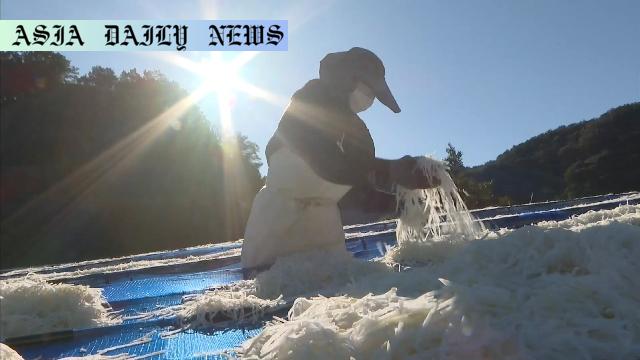Farmers in Mihama Town, Japan, embrace mid-winter winds to produce the traditional kiriboshi-daikon.
- Farmers in Japan are producing the traditional kiriboshi-daikon.
- The radish strips are sun-dried in ideal mid-winter conditions.
- This year’s weather is offering outstanding production quality.
- The town expects to ship 3 tons across Japan by February end.

Introduction
In the heart of central Japan, the picturesque town of Mihama in Mie Prefecture is renowned for its dedication to traditional culinary techniques. One such specialty is the production of kiriboshi-daikon, a sun-dried, shredded radish that is deeply rooted in Japanese culture. This mid-winter treat has been perfected over generations, relying on the cold, dry winds and sunny days to create its signature taste and texture. As the season unfolds, farmers in the region work tirelessly to bring this cherished delicacy to homes across Japan.
The Tradition Behind Kiriboshi-Daikon
Kiriboshi-daikon is not merely a food item; it’s a testament to the deep connection between nature and culinary heritage. The production process begins early in the morning, with farmers carefully slicing radishes into strips about 10 centimeters long. These strips are then meticulously laid out on nets, allowing sunlight and the region’s distinct winter winds to dry them evenly. Over the course of three days, the strips transform, losing an astonishing 95% of their weight but gaining an impressive concentration of sweetness and flavor. This transformation speaks to the profound alchemy of nature and human dedication.
Ideal Environmental Conditions
Mihama Town’s geographical location provides the perfect weather for producing kiriboshi-daikon. The combination of mild winters, dry conditions, and consistent winds ensures that the radish strips dry uniformly without losing their quality. This year, in particular, has seen stable weather patterns, much to the delight of farmers like Nose Masaki, who note that the pleasant winds are yielding an exceptional product. Such favorable conditions not only enhance the flavor but also reinforce Mihama’s reputation as a hub for this unique delicacy.
From Farm to Table
Once the drying process is complete, the radish strips are packed and prepared for shipping. This year, Mihama Town is set to produce approximately 3 tons of kiriboshi-daikon, which will be distributed to the Tokai, Kanto, and Kansai regions. The demand for this traditional food underscores its enduring popularity and the appreciation for regional specialties in Japanese cuisine. Furthermore, the labor-intensive nature of its production highlights the commitment of local farmers to preserving this cultural tradition.
The Growing Popularity of Kiriboshi-Daikon
Kiriboshi-daikon has been gaining attention far beyond the borders of Japan. Its versatility and nutritional benefits, coupled with its delicious taste, have made it a sought-after ingredient in various dishes, from soups to stir-fries. The drying process not only intensifies its flavor but also increases its shelf life, making it a convenient and reliable addition to households worldwide. Its association with traditional Japanese cuisine further enhances its appeal, offering a glimpse into the intricate world of regional food cultures.
The Human Element
The dedication of farmers in Mihama Town is evident in every step of the kiriboshi-daikon production process. Rising before dawn to ensure that each radish strip is placed just right, their work is a labor of love. This careful attention to detail, combined with their reliance on natural elements, ensures that each batch of kiriboshi-daikon maintains consistent quality. For farmers like Nose Masaki, the success of each production season is not just a professional achievement but also a personal triumph in preserving a cherished tradition.
Conclusion
As the season progresses and Mihama Town’s farmers continue their work, the tradition of kiriboshi-daikon serves as a reminder of the beauty of simplicity and the importance of preserving cultural heritage. Through their efforts, they ensure that this humble yet extraordinary food remains a staple in Japanese cuisine, celebrated for its flavor and the craftsmanship behind its creation. Whether enjoyed in a hearty winter stew or as an ingredient in a signature dish, kiriboshi-daikon brings a piece of Mihama’s charm to tables across Japan and beyond.



Commentary
Nurturing Traditions
Tradition is a cornerstone of culture, and the production of kiriboshi-daikon in Mihama Town exemplifies this ethos perfectly. In a fast-paced world where convenience often overshadows authenticity, the dedication of farmers to this labor-intensive process is truly inspiring. It’s not just about creating a product; it’s about maintaining a connection to the past, honoring the methods passed down through generations, and ensuring that these traditions are not lost in the rush of modernization.
The Role of Nature
One of the most fascinating aspects of kiriboshi-daikon production is the reliance on natural elements. The cold, dry winds and sunny days of Mihama Town act as co-creators in this process. This interplay between human effort and environmental factors showcases the harmony that can exist between people and nature. It is a reminder that, sometimes, the best outcomes are achieved not through artificial methods but by working in tandem with the natural world.
Cultural Preservation
Kiriboshi-daikon is more than just a food item; it’s a cultural artifact. In an era where globalization often homogenizes cuisines, the preservation and celebration of regional specialties like kiriboshi-daikon become vital. By continuing to produce and promote this unique product, the farmers of Mihama Town provide a glimpse into the rich culinary diversity that Japan has to offer, ensuring that these traditions are not merely remembered but actively appreciated.
Final Thoughts
As consumers, there’s a lot we can learn from Mihama’s farmers and their dedication to kiriboshi-daikon. Beyond the delicious taste of their product lies a story of resilience, tradition, and harmony with nature. It’s a story worth cherishing, reminding us to value the origins of what we consume and the hands that work tirelessly to bring these foods to life.